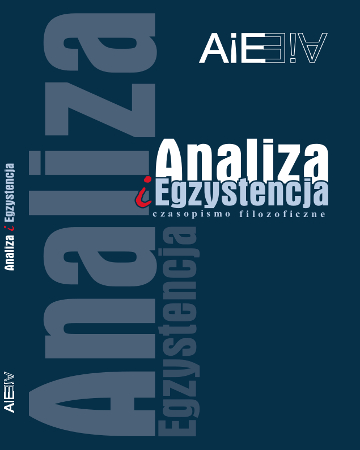
ISSN: 1734-9923
eISSN: 2300-7621
OAI
DOI: 10.18276/aie.2019.48-04





Issue archive /
48 (2019)
Kształtowalność. Próba rewizji struktur Heideggerowskiego bycia w czasach antropocenu
(Shapeability. Revisiting Heidegger’s Concept of Being in the Anthropocene)
| Authors: |
Magdalena
Hoły-Łuczaj

Wyższa Szkoła Informatyki i Zarządzania w Rzeszowie |
| Keywords: | Heidegger Anthropocene structure of beings ethics |
| Data publikacji całości: | 2019 |
| Page range: | 23 (65-87) |
Abstract
This paper addresses the problem of whether beings in Heidegger can affect each other and the significance of this phenomenon for their being and the ownmost. It seems that Heidegger’s concept of being lacks the dimensions of shaping and being shaped by others. However, it is possible to revise his concepts of fundamental structures of being, such as temporality and worldliness, thereby creating the structure of “shapeability”, which would not be limited to human beings. This, in turn, can help elucidate one of the key dilemmas of the Anthropocene related to setting the boundary between footprint and harm.
Download file
Article file
Bibliography
| 1. | Backman, J. et al. (2019). ‘Gatherings Symposium–Beyond Presence?’, Gatherings: the Heidegger Circle Annual, 9. |
| 2. | Baran, B. (1989). Saga Heideggera. Kraków: Wyd. PAT. |
| 3. | Bennett, J. (2010). Vibrant Matter: A Political Ecology of Things. Durham: Duke University Press, 2010. |
| 4. | Bińczyk, E. (2018). Epoka człowieka. Retoryka i marazm antropocenu. Warszawa: Wydawnciwto Naukowe PWN. |
| 5. | Borowska, E. (2014). Heideggerowska destrukcja metafizyki: filozofia średniowieczna i nowożytna. Część I, Ruch Filozoficzny, LXXI (1). |
| 6. | Buczyńska-Garewicz, H. (2003). Metafizyczne rozważania o czasie. Kraków: Universitas. |
| 7. | Buczyńska-Garewicz, H. (2006). Miejsca, strony, okolice. Przyczynek do fenomenologii przestrzeni, Kraków: Universitas. |
| 8. | Calarco, M. (2008) Zoographies: The Question of the Animal from Heidegger to Derrida, New York: Columbia University Press. |
| 9. | Derrida, J., (2008). The Animal That Therefore I Am, transl. D. Willis, New York: Fordham University Press. |
| 10. | Dreyfus, H. (2002). Heidegger’s History of the Being of Equipment. W: Hubert Dreyfus, Harrison Hall (red.), Heidegger: A Critical Reader, Oxford: Blackwell. |
| 11. | Heidegger, M. (1983). Die Grundbegriffe der Metaphysik. Welt-Endlichkeit-Einsamkeit, Frankfurt am Main: Vittorio Klostermann. |
| 12. | Heidegger, M. (1987) Zollikoner Seminare: Protokolle-Gespräche-Briefe Herausgegeben von Medard Boss, Frankfurt am Main: Vittorio Klostermann. |
| 13. | Heidegger, M. (1992) O źródle dzieła sztuki, tłum. L. Falkiewicz, Sztuka i Filozofia, 5. |
| 14. | Heidegger, M. (1996). Przyczynki do filozofii. Z wydarzania, przeł. B. Baran, J. Mizera, Kraków: Wydawnictwo Baran i Suszczyński. |
| 15. | Heidegger, M. (1997c). Besinnung, Frankfurt am Main: Vittorio Klostermann. |
| 16. | Heidegger, M. (1997a). Powiedzenie Anaksymandra, tłum J. Sidorek, [w:] idem, Drogi lasu, Warszawa: Aletheia. |
| 17. | Heidegger, M. (1997b). Źródło dzieła sztuki, tłum J. Mizera, [w:] tegoż, Drogi lasu, tłum. J. Gierasimiuk i in., Warszawa: Aletheia. |
| 18. | Heidegger, M. (1999). List o »humanizmie«, tłum. J. Tischner, [w:] idem, Znaki drogi, Warszawa: Aletheia. |
| 19. | Heidegger, M. (2000). Co zwie się myśleniem?, przeł. J. Mizera, Warszawa: Wydawnictwo Naukowe PWN. |
| 20. | Heidegger, M. (2001). Pytanie o rzecz. Przyczynek do Kantowskiej nauki o zasadach transcendentalnych, przeł. J. Mizera, Warszawa: Wyd. KR. |
| 21. | Heidegger, M. (2002a) Pytanie o technikę, tłum. J. Mizera, [w:] idem, Odczyty i rozprawy, Kraków: Wydawnictwo Baran i Suszczyński. |
| 22. | Heidegger, M. (2002b). Budować, mieszkać, myśleć, tłum. J. Mizera, [w:] idem, Odczyty i rozprawy, Kraków: Wydawnictwo Baran i Suszczyński. |
| 23. | Heidegger, M. (2002c). „…poetycko mieszka człowiek…”, tłum. J. Mizera, [w:] idem, Odczyty i rozprawy, Kraków: Wydawnictwo Baran i Suszczyński. |
| 24. | Heidegger, M. (2002d). Przezwyciężenie metafizyki, tłum. J. Mizera, [w:] idem, Odczyty i rozprawy, Kraków: Wydawnictwo Baran i Suszczyński. |
| 25. | Heidegger, M. (2005). Bycie i czas, przeł. B. Baran, Warszawa: Wydawnictwo Naukowe PWN. |
| 26. | Heidegger, M. (2007). Ontologia (Hermeneutyka faktyczności), tłum. M. Bonecki, J. Duraj, Nowa Wieś: Wydawnictwo Rolewski. |
| 27. | Heidegger, M. (2009), Podstawowe problemy fenomenologii, przeł. B. Baran, Warszawa: Aletheia. |
| 28. | Jaran, F., Perrin C. (2013). The Heidegger Concordance. London: Bloomsbury. |
| 29. | Kettering, E. (1987). Nähe. Das Denken M. Heideggers, Pfullingen: Neske 1987. |
| 30. | Kleinberg-Levin, D. (2005). Gestures of Ethical Life: Reading Hölderlin’s Question of Measure After Heidegger, Stanford: Stanford University Press. |
| 31. | Lemmens, P., V. Blok, J. Zwier, (2017). ‘Toward a Terrestrial Turn in Philosophy of Technology,’ Techné: Research in Philosophy and Technology, 21(2–3). |
| 32. | Malabou, C. (2017) Ontologia przypadłości. Esej o plastyczności destrukcyjnej, tłum. P. Skalski, Warszawa: Fundacja Hr. Cieszkowskiego. |
| 33. | Mizera, J. (2006). W stronę filozofii niemetafizycznej. Martina Heideggera droga do innego myślenia, Kraków: Wyd. UJ. |
| 34. | Richardson, W.J., (2003). Heidegger, Through Phenomenology to Thought, New York: Fordham UP. |
| 35. | Thomson, I. (2004). ‘Ontology and Ethics at the Intersection of Phenomenology and Environmental Philosophy,’ Inquiry, 47. |
| 36. | Vogel, S. (2015). Thinking like a Mall. Cambridge: MIT Press. |
| 37. | Yates, C. (2013). ‘Poetizing and the Question of Measure’, Studia Philosophiae Christianae UKSW, 49(4). |
| 38. | Zimmerman, M. (1990). Heidegger’s Confrontation with Modernity: Technology, Politics, and Art. Bloomington: Indiana University Press. |
| 39. | Zwier, J., V. Blok. (2019). ‘Seeing Through the Fumes: Technology and Asymmetry in the Anthropocene,’ Human Studies. |